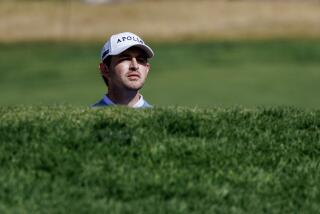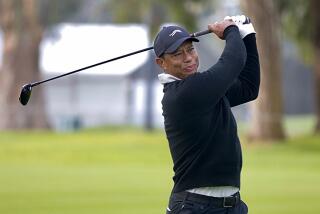Woods Hopes Northern Exposure Pays Off : Golf: Former Anteater is playing the Canadian tour, trying to sharpen his game for one of the richer tours.
- Share via
PONOKA, Alberta — The way Eric Woods reads them, all the greens in Canada break toward the PGA Tour.
Or Europe. Or Australia. Or just about anywhere golf is played for six- and seven-figure purses.
No, last week’s $125,000 Canadian Home Alberta Open wasn’t The Masters. Neither are any of the upcoming stops on the Canadian Professional Golf Assn. tour.
But there’s good money to be won on the CPGA tour, which is why Woods, a Corona del Mar resident, is spending his summer north of the border.
“The whole idea of being a golf pro is to make money,” Woods said. “You have to follow the cash. It’s what I do for a living, so you go where there’s chances to earn that living.”
Most U.S. golf fans are spoiled by the images of Fred Couples and Davis Love III playing for $180,000 or more in first-place money from week to week. At last week’s Federal Express St. Jude Classic, Jim McGovern made $52,800 for finishing fourth.
At the British Columbia Open early this month in Vancouver, Woods made $4,500 for finishing fourth.
By comparison, Woods’ biggest payday doesn’t seem like much, but to him, it was a sign that his up-and-down golf career is on the way up again.
“Things are finally going good again,” Woods said. “I feel like I’m going to make money now.”
That’s a different feeling than Woods had soon after he turned pro in 1987 at 23. After earning co-MVP honors on UC Irvine’s golf team in 1986, Woods’ strong play in a number of prestigious amateur events convinced him he was ready to tee it up in events in which more than just a trophy and a handshake were on the line.
Woods, a former all-Southern Section football player at Corona del Mar High School, advanced to the semifinals of the California Amateur and the Western Amateur in the summer of 1986, and originally planned to play professionally in Asia that fall.
“When I told my dad about that, he just laughed, especially when I asked him to pick up the tab for a while,” Woods said. “He told me to go back to UCI and finish my degree and then we’d see about turning pro.”
Woods earned his degree in social science in 1987 and then went to Australia, where he earned his tour card and officially turned pro. A virtually self-taught player, Woods relied on his natural ability in college and amateur events, but soon discovered that wasn’t enough to be successful against the pros.
“I had no knowledge of the golf swing or even about golf,” Woods said. “The ball just went where I aimed it, but there’s more to it than that.”
Although he struggled in Australia, Woods remained confident he could support himself as a golfer. He formed a sponsoring partnership with family members and businessmen, which put $75,000 in the bank and enabled Woods to devote himself to his profession full time.
It didn’t work out as well as he’d planned.
“That was the beginning of the nightmare,” Woods said.
He went to the PGA Tour School, where he missed the four-day cut of the six-round qualifying tournament. Woods then began taking lessons from “anybody and everybody” in an attempt to move his game to the next--profitable--level.
Hoping his game was ready, he returned to Australia and proceeded to miss every cut.
“I was trying to learn how to play golf and make money at the same time,” Woods said. “It was a total disaster.”
After returning to the United States, Woods dissolved the partnership in December, 1989, and returned the money to his sponsors.
“I had no idea what I wanted to do with my life then, so I knew I couldn’t keep taking the money when I wasn’t making anything in golf,” he said.
While considering other careers--those of the nine-to-five variety--Woods supported himself by giving indoor video golf lessons at Don Mollica’s golf school in Irvine. It wasn’t long before he discovered that golf still held his interest and that he wanted to play professionally again.
Through 1990, Woods played on California’s Golden State Tour, but he didn’t play well.
“I was just giving my entry fees away,” he said. “I’d go out and shoot 75 or 76 and be out of the money.”
The turning point in Woods’ career came late in 1990, when he began working with San Diego teaching pro Kip Puterbaugh. Puterbaugh helped Woods put his game together, starting with the basic fundamentals of the swing. “We spent 10 months on the take-away itself,” Woods said.
Woods’ game improved rapidly, and he was able to find a new sponsor in Jeff Katke, owner of a vitamin and nutritional supplement company in San Clemente. In his first tournament under Katke’s sponsorship, the Spaulding Invitational at Pebble Beach, Spyglass Hill and Poppy Hills in January, 1991, Woods qualified for the event’s last spot with a birdie on the first hole of an eight-man playoff.
He went on to earn $2,700 in the tournament, which boosted his confidence. Later that month, Woods made his debut in a PGA event at the AT&T; Pebble Beach National Pro-Am, where he shot 69 the first round but missed the cut for the final round.
Back on the Golden State Tour, Woods continued to finish in the top 10 consistently, which led him to the Canadian tour school in the spring of 1991. He earned his CPGA card and made $4,700 in nine tournaments last summer, finishing 64th on the money list.
“I didn’t make a lot of money, but I got a lot of experience and my stroke average (71.6) was 33rd overall,” Woods said. “That made me realize I could have made a lot more money if I got a little more consistent.”
Woods considered going to South America to play last fall, but Katke persuaded him to go back to Puterbaugh and continue to play the Golden State tour. The move paid off and Woods continued to play well in Golden State events.
This spring, he finished third at the Fresno Open, making $2,500. “I made money at every tournament I played in,” Woods said. “That was the first time that happened.”
Now Woods is back on the CPGA tour, where he plans to play in 12 events this summer. In October, he plans to go through the PGA Tour school again.
Although he missed the cut June 12 in the Alberta Open after shooting 70-79, Woods believes his summer in Canada will be profitable.
“I’m playing golf like an athlete again instead of being a robot,” he said. “I have feel and experience now and I’m making money this year.
“I know the direction my game is going in, and for any golf pro, ideally that direction is the PGA Tour.”
That, after all, is where the money is.
More to Read
Go beyond the scoreboard
Get the latest on L.A.'s teams in the daily Sports Report newsletter.
You may occasionally receive promotional content from the Los Angeles Times.









